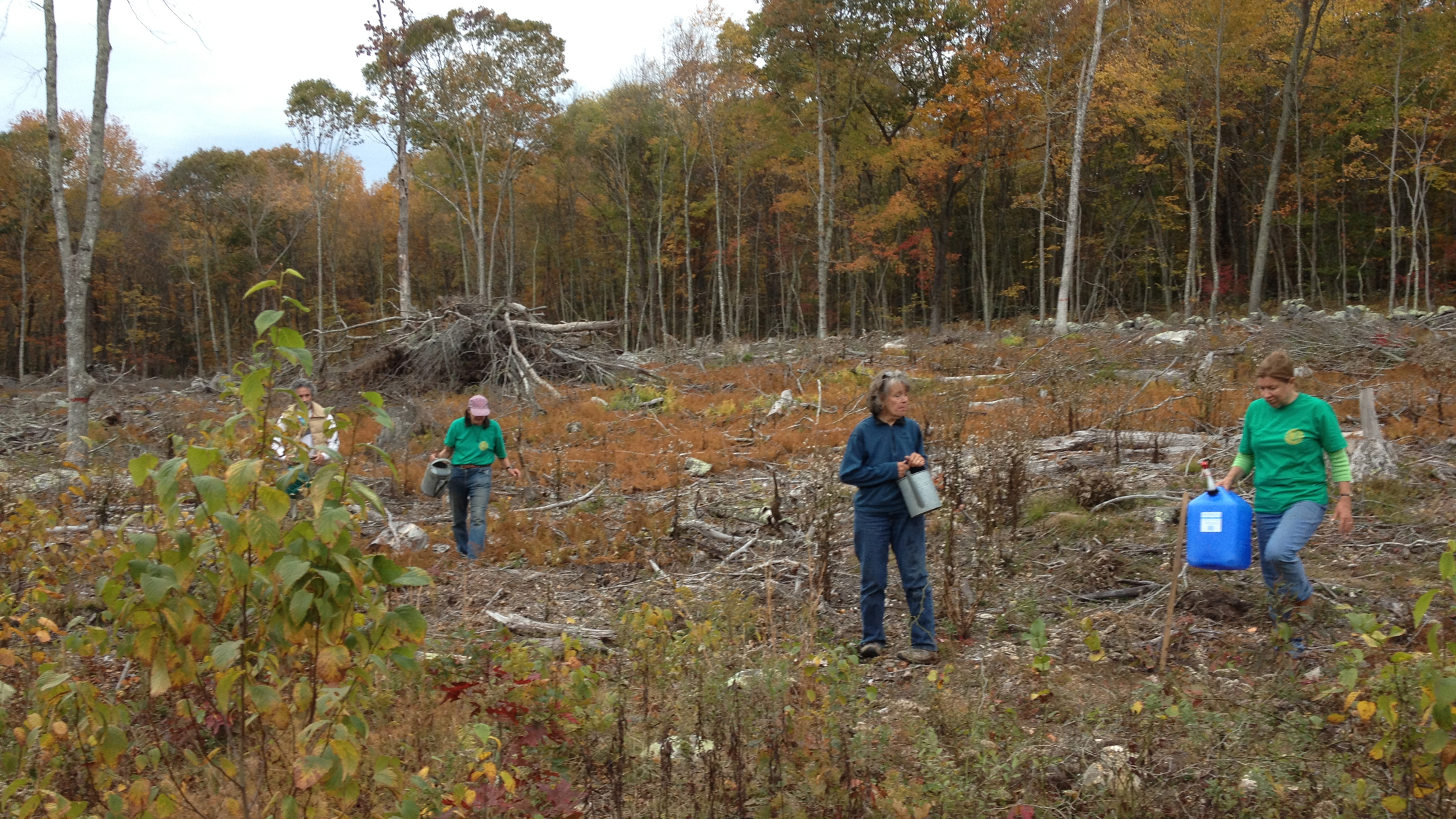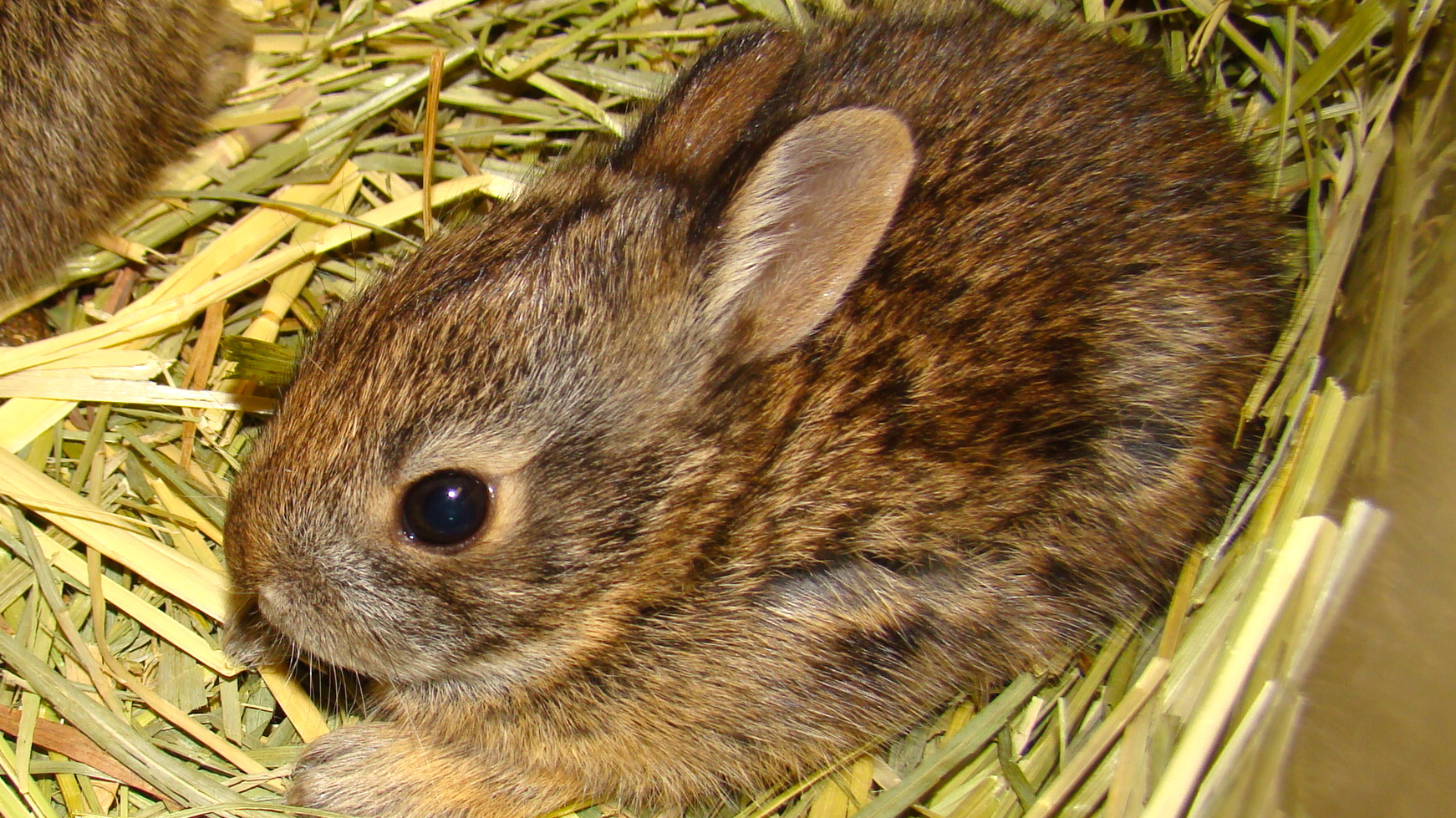Stunned but delighted is how Dr. Robert McDowell, Director of Wildlife at the University of Connecticut, sounded when I arrived at his office to learn about New England cottontail rabbits.
Finally someone other than himself was interested in these vanishing natives. We pored over skulls and skins and vainly patrolled early successional woods for live specimens. McDowell seethed about the mindset of state fish and game bureaucrats: we can’t waste time on a few native rabbits when we have so many look-a-like non-natives and when license buyers want more pheasants, ducks and deer.
The year was 1983.
The non-natives, called “eastern cottontails,” are a genetic mishmash of species and subspecies plucked from Minnesota, West Virginia, Kansas, Missouri, Texas, Arizona and New Mexico. From the late 1800s to the early 1970s fish and game agencies in the Northeast permitted, encouraged and initiated stocking of these aliens. The result is a tough, adaptable mongrel imbued with hybrid vigor that outcompetes the fragile, specialized native.
In the field even biologists can’t tell an eastern cottontail from a New Englander, but under the skin they’re very different beasts, apparently incapable of hybridization. Easterns can make a living most anywhere, including the young forests on which New England cottontails depend and which, because of fire suppression and beaver-dam control, we’re running out of.
Thanks largely to people like McDowell and Dr. John Litvaitis, a wildlife professor at the University of New Hampshire, there has been a sea change in attitudes. Major funds started pouring in for habitat work when the National Fish and Wildlife Foundation and the Wildlife Management Institute (WMI) got interested in New England cottontails. Now New York and every New England state (save Vermont where the species has been extirpated) is represented on a New England Cottontail Technical Committee. A state, federal and private partnership called the New England Cottontail Initiative is undertaking young-forest restoration rangewide. And rabbits are being raised for release at the Roger Williams Park Zoo in Rhode Island, the Queens Zoo in New York, and Great Bay National Wildlife Refuge in New Hampshire.

On December 14, 2016 America’s newest national wildlife refuge — the Great Thicket, taking in parts of all six New England cottontail states, was jump-started by a gift from The Nature Conservancy of its 144-acre Nellie Hill Preserve in Dover Plains, New York. In addition to native cottontails the refuge will provide habitat for dozens of other depressed young-forest-dependent species.
The New England cottontail had been a candidate for Endangered Species Act protection, but on September 11, 2015 the U.S. Fish and Wildlife Service determined that listing was not warranted because of all the recovery work.
I wish McDowell could have been with me and my wife Donna on May 17, 2017 when Wayne Woodard, director of The Nature Conservancy’s 1,900-acre Sunny Valley Preserve in Bridgewater, Connecticut, showed us the kind of work the partnership is doing.
Serenaded by bobolinks, yellow warblers, common yellowthroats, American redstarts and red-winged blackbirds, Woodard, Donna and I hiked along meadows managed for grassland birds. In the distance unfurling leaves of mature hardwoods glowed chartreuse in full afternoon sun. Much of this forest, the bane of New England cottontails, is scheduled for clearcutting, but first the understory of invasive barberry needs to be removed. A year earlier a contractor had herbicided a 25-acre plot on the uphill (east) side of a stonewall because barberry seeds mostly by gravity. The contrast with the grossly infested west side was striking. “We had a 95-percent kill rate,” said Woodard. “We’ll go back and treat what’s left, then next winter we’ll do a clearcut.” Barberry on the west side of the stonewall is scheduled for herbiciding, too.
Much of the public reviles herbicides. But Woodard has done extensive outreach, so opposition is less intense here than at other sites. “By July first we’ll have cleared invasives from 70 acres,” he said. “We couldn’t possibly have done that without herbicides. It would have been like putting out a forest fire with a bucket brigade.”

Multiflora rose is one invasive that Woodard has to leave until native shrubs get established. “Rabbits love it,” he said. “That’s what’s kept this abandoned farmland from reverting to forest.”
Deer densities in this part of the East are among the highest in the nation. Deer are spreading invasives, eating natives that provide thicket habitat for New England cottontails and eliminating ground-and shrub-nesting birds. So ten years ago the Conservancy opened the preserve to controlled deer hunting.
“With clearcuts,” explained Woodard, “we’re trying to replicate natural disasters like fires and hurricanes.” In another section of the preserve he showed us a recent clearcut that was strewn with tops and slash to serve as temporary rabbit cover and protection from deer browsing until native vegetation fills in. In nature the word “ugly” has no meaning.
Helping the Conservancy and other partners with habitat work has been Lisa Wahle, a WMI contract biologist working with the Connecticut Department of Energy and Environmental Protection.
“Our biggest issue is people not wanting to cut trees,” she told me. “They’ve heard lots of drum beating about forest fragmentation from clearcuts; but we’re not doing clearcuts like on the West Coast. We started out asking for 25 acres, and quickly backed off that. The minimum patch that NRCS will pay for is six acres. But even six acres is a lot to ask for people who aren’t used to seeing clearcuts. Depending where they’re sited, there may be some initial fragmentation and perhaps cowbirds.”
But these cuts grow back lush and fast, and then they’re just roaring with shrubland species. Interior forest species use them too — it’s where the food is, she continues. “People I’d expect to be more tuned in to the value of occasional patches of young forest are still opposed. In northwest Connecticut there’s even a push for ‘forever wild’ status, which basically puts an easement on your property so you can’t manage it for anything — ever!”

But, like Woodard, Wahle and her colleagues are big on outreach. And, along with frustrations, she cites major successes with land trusts, sportsmen’s clubs and private landowners.
David Gumbart, who directs land management for The Nature Conservancy in Connecticut, reports that New England cottontails have recently been documented on the Conservancy’s Lord Cove Preserve in Lyme. “Wherever we have them we invest in management,” he says.
Captive breeding has progressed to the point that New England cottontails are now being conditioned to the wild before release. When Donna and I inspected the rabbits being raised at the Roger Williams Park Zoo by conservation director Lou Perrotti we began to see a few of the subtle markings that distinguish them from the aliens. They were a bit darker and smaller. Ears were trimmed with fine, black fur and they lacked the white forehead spots common on easterns.

These and other of the zoo’s rabbits have been released on Patience Island in Narragansett Bay. So robust is the population there that animals are being live trapped and sent to the new outdoor breeding facility at Great Bay National Wildlife Refuge in New Hampshire and released in Rhode Island’s Great Swamp Wildlife Management Area.
Rabbits bred at the zoo have also been released at the Bellamy River Wildlife Management Area, biggest habitat restoration site in New Hampshire. When I caught up with manager Jim Oehler he and 87 volunteers had just planted 10,500 native shrubs. And he’s been clearcutting. Eventually 200 acres, nearly half the property, will be converted to young forest.
One thing New England cottontails have going for them is that the public considers them “cute,” an advantage many vanishing species — timber rattlesnakes, for example — lack. In addition to New England cottontails Lou Perrotti has been raising timber rattlers, more endangered in New England than any other species. This was part of a project by the Massachusetts Division of Fisheries and Wildlife to prevent extirpation by establishing a colony on an uninhabited island in the middle of the state’s sprawling Quabbin Reservoir. No one gets bitten by these shy, reclusive snakes; they’re no more dangerous to humans than rabbits, and the island is off limits to the public. But last April, after years of patient education by the Division, snake haters shouted down the project.
For the most part, the American public has yet to grasp what McDowell and Litvaitis understood from the start and what fish and game bureaucrats have learned since 1983 — that imperiled species need to be saved not because they are “cute,” not because they are “beautiful,” not because they are useful, not because they are anything. Only because they are.





I am very glad that there are people who care enough to do all that they do to help the Rabbits.
Once they are gone, there’s no bringing them back. This is not only shameful but should be considered a crime.
Excellent article, and thanks for making it possible. I had no idea the “Yankee rabbits” were so distinct, and why it makes a difference to restore their habit in the midst of competition from hybrid animals. I’m surprised they’ve made it so far.
We now have many similar issues now in “the West” (at least along Colorado’s central Front Range), and they seem more prominent in our local and regional news. Forest management ideas are changing, local residents are becoming a more concerned part of the equation, over-crowding has begun affecting land use, and human-induced habitat change and species modifications have integrated with local conservation / management issues.
The West is becoming more like the East.
Save all wildlife! Don’t harm any for any reason.
Save nature!
Thank you for this update and info on the New England cottontail. i remember these as a child. We lived near swampy land and there were many of them. This was in Tilton, New Hampshire about 70 years ago when i would see them so often.
thank you for all you do for wildlife! mattie goodwin
This is awesome! Thank you for caring for these beautiful little creatures. So many “environmentalists” get upset over things they do not understand.
We need to love and care for Gods creatures
Very interesting column, Ted. Need more mention of Donna, however.
We once had rabbits and quail and pheasants around here now just feral cats
The cotton tail rabbits here in Michigan seem plentiful and healthy- every yard has them. So is it a different species that is endangered?
Hi Annis: Yes, the rabbits you see are most likely a mix of subspecies–the result of thoughtless stocking during the age of ecological unawareness. New England cottontails, while not officially “endangered,” are drastically depressed. They’re restricted to New England (except Vermont) and New York.
Lisa Wahle asked me to note that New England cottontail projects are largely funded by the Natural Resources Conservation Service.